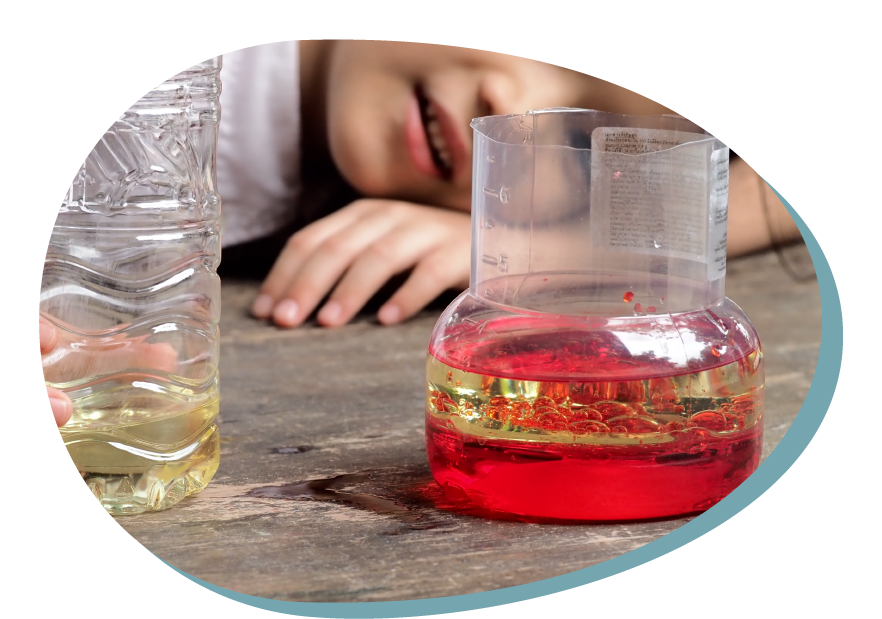Can the oil drown? Investigating density
Type of resource: You Tube video
Web address https://www.youtube.com/watch?v=Vtywn6z5xB8
Language: English
Description
Investigating liquids density with water and oil; drowning the oil with the use of different kitchen substances such as: salt, sugar, patoto flour, plain flour, rice, grain, tea and coffeee. Experimenting in the kitchen.
Scientific concept introduced
liquid density; weight of water and oil; cocoa; mixing; measuring; weighting; sugar; potato flour; plain flour; rice; groat; tee; coffee.
Creative and critical thinking
–
Mathematical reasoning
Measuring and weighing liquids
Scientific thinking
Scientific thinking: observing, predicting, drawing conclusions, formulating hypotheses
Learning how to learn
Curiosity, motivation and engagement, undertaking reflexion on the course and effects of one’s own learning
Additional
Language competence: learning scientific vocabulary, Learning how to cooperate in small teams (teamwork and cooperation); FIne motor skills development; Following safety rules.
Can the oil drown? Investigating density
Overall aims
– Developing scientific concepts related to the density and volume of different liquids;
– Learning to cooperate to achieve common aims;
– Developing curiosity and interest in natura (biological phenomena);
– Developing scientific thinking and the ability to run scientific experiments.
Vocabulary – keywords should be understood
liquid density; weight of water and oil; cocoa; mixing; measuring; weighting; sugar; potato flour; plain flour; rice; groat; tee; coffee
Expected learning outcomes (operational aims)
The child will be enabled to:
– measure the given amount (volume) of liquid;
– use simple kitchen tools (spoon, glass, measuring scoop; kitchen scale)
– correctly and precisely name investigated phenomena
– independently run the experiment described by a teacher
– analyze and draw conclusions from the experiment
– experience, observe and investigate scientific concepts
STEM skills – to which the learning unit is related to
CORE STEM SKILLS
Mathematical thinking: measuring and weighing liquids
Scientific thinking: observing, predicting (formulating hypothesis), drawing conclusions.
Learning how to learn: curiosity, motivation and engagement, undertaking reflexion on the course and effects of one’s own learning
ADDITIONAL SKILLS
Language competence: learning scientific vocabulary.
Learning how to cooperate in small teams (teamwork and cooperation);
FIne motor skills development
Following safety rules
Teaching methodologies/activity outline
1. Building problem situation:
Questions:
What are we using the oil and water for?
What are the characteristics (qualities) of water and oil?
What will happen if we pour oil into the water – will these two substances mix with each other?
Children conduct the experiment in small teams to answer the question – Can the oil mix with water? They pour the water to the glasses (half of the glass), then add 6 spoons of oil and mix carefully. Children observe the results and answer the question: Did oil and water mix together?
Research question:
Can the oil drown? What can we do to force the oil to drown?
2. Formulating predictions (hypothesis):
The writes down the children predictions and ideas
3. Verifying hypothesis:
– Running experiments in small teams
Every team receives another substance (such as: sugar, potato flour, plain flour, rice, tee or coffee). To the glass or far with water and oil children are adding different substances. Then they add salt and observe the results
4. Summarizing the results and drawing conclusions:
Questions:
– Which substance caused the oil to fall down (drown) for a moment and why? (the teams are presenting and explaining their results)
– Why does the oil float on the surface of the water and does not want to drown?
– The oil has a higher density than water – does it mean that it is heavier? (children are weighting the glass of water and the glass of oil, comparing their weight)
5. Explanation for teacher:
Some products (substances) when mixed with salt may cause the oil to drown.
Salt has a higher density than water and oil, and that is why it falls down into the bottom. When falling down the salt drags the cocoa/ flour/ coffee and drops of oil – causing them to fall down too. However the salt melts quickly, and the drops of oil released from salt, are floating again on the top of water.
The oil floats on water because it has a lower density than water. The density means what weight is related to a certain volume of substance – the lower of a certain substance density is, the smaller is its weight.
The oil does not mix with water because these two substances have a different molecular structure. The water weighs less than the oil.
Assessment of learning
Children assess the activity by assigning the points from 1 to 5.
Equipment and materials to be used in learning unit (tools, ingredients etc)
Bottle of oil, water, jar or glasses (for every team), woda, jug for water, kitchen scale, spoons for every team, substances such as: cocoa, tee, coffee, salt, sugar, potato flour, plain flour, rice and groats (few spoons of each), decanters with oil
Kind of setting
Preschool classroom
References – source
Can the oil drown? Investigating density
1. Usefulness for STEM education – integrating content of different disciplines
Cross-curricular character of the resource

The range of S-T-E-M subjects included

The presentation of possibilities of including artistic activities (STEAM approach)

2. Expected learning outcomes
Consistency (links) with preschool core curriculum

Communicativeness of description

3. Methodology of teaching
Clarity, communicativeness of instructions for teachers

Meaningful learning – using practical life problems

Original idea

The level of ease in implementing the methodology to preschool age children

The level of ease in preparing necessary ingredients, materials and equipment needed

4. Sustainability
Ecological characteristics of materials/ results

Supporting healthy eating habits

Low ecological footprint

Possibilities of inclusion (respecting cultural diversity and food intolerances)

5. Class management
Using differentiated forms of work – individual, team work etc.

Individual work

Team work

Whole group
6. Time management

Short activity (10-15 minutes)

Medium activity (20-30 minutes)

Long activity (1 hour or more)

Very long activity (1 day or more)
PDF: https://www.printfriendly.com/p/g/BJjnn4

